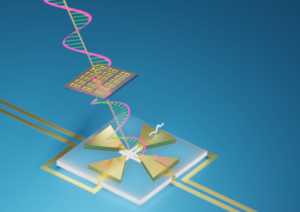3D-cross nanowire networks for terahertz detectors

Terahertz radiation encompasses a region of the electromagnetic (EM) spectrum between microwave and infrared (IR) light, with frequencies typically in the range from 0.1 THz to 30 THz. It is often called the band where electronics meets optics. This mixed property leads to a wide variety of terahertz applications, including wireless communication, remote sensing, security screening, spectroscopy and imaging.
Time-domain spectroscopy (TDS) in materials characterisation is a powerful example of the use of terahertz radiation. It is a bit like an ultrasound but makes use of some of the special properties of terahertz radiation, such as recording information over a broad spectral range, allowing construction of spatial maps of material properties. This technique is useful in pharmaceutical quality control, medical diagnostics and production-line inspection.
The vast majority of terahertz TDS systems are based on the generation and detection of linearly-polarised single-cycle terahertz pulses. Such systems are not polarisation-sensitive, which limits their ability to image specific properties of materials. Much richer data can be achieved through terahertz polarimetry, which requires the polarisation-sensitive detection of terahertz waves. Terahertz polarimetry enables the non-contact THz Hall characterisation of semiconductors quality and the analysis of metamaterials.
Material system to detect terahertz radiation
Current methods of polarisation-sensitive detection of terahertz waves involve measuring polarisation components separately. However, this technique is time-consuming and prone to error. Even with detectors capable of measuring the terahertz electric field vectors simultaneously, there is the issue of crosstalk (interference) across measurement channels which limits their practical use.
To address the problems mentioned above, researchers at the University of Oxford have devised a new polarisation-sensitive detector. The technology is based on semiconductor nanowires, which are single crystals only a fraction of a micron wide, like building blocks. By careful positioning of nanowires on a monolithic chip and the integration of a complementary electronics module, multiple electric field components can be recorded simultaneously and without cross-talk.
Initial proof-of-concept demonstrators of the new technology have been created, and the research team is now working to integrate the new detectors in existing ‘off the shelf’ terahertz systems.
Commercialisation
A patent application covering the new concept is on file, and we are now seeking commercial partners to progress the project further.
about this technology

